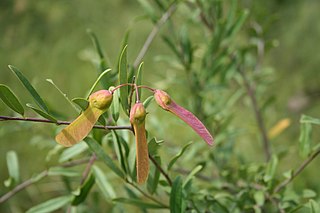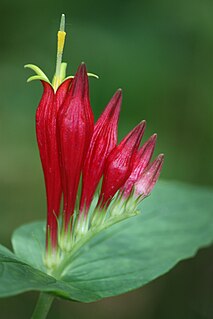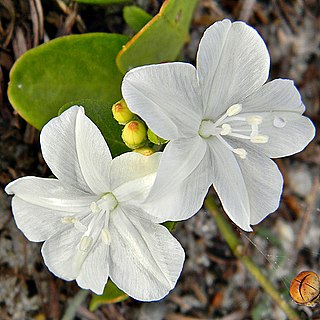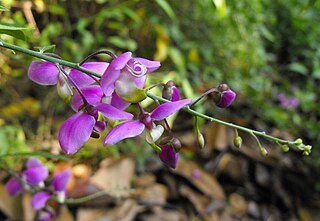
The Cyperaceae are a family of graminoid (grass-like), monocotyledonous flowering plants known as sedges. The family is large, with some 5,500 known species described in about 90 genera, the largest being the "true sedges" genus Carex with over 2,000 species.

Ageratum is a genus of 40 to 60 tropical and warm temperate flowering annuals and perennials from the family Asteraceae, tribe Eupatorieae. Most species are native to Central America and Mexico but four are native to the United States.

The Polygalaceae or the milkwort family are made up of flowering plants in the order Fabales. They have a near-cosmopolitan range, with about 21 genera and ca. 900 known species of herbs, shrubs and trees. Over half of the species are in one genus, Polygala, the milkworts.

Lepechinia is a genus of plants in the mint family, Lamiaceae. It includes several species of plants known commonly as pitchersages. Plants of this genus can be found in Central and South America, Mexico, California, Hispaniola, and Hawaii, although the species in Hawaii is probably a human introduction. Many of them bear attractive pitcher-shaped flowers, often in shades of purple. The genus was named for the Russian botanist Ivan Ivanovich Lepechin. Recently, the two monotypic genera Chaunostoma and Neoeplingia were shown to be part of Lepechinia.
- Lepechinia anomalaEpling - southern Brazil
- Lepechinia bellaEpling - Bolivia
- Lepechinia betonicaefolia(Lam.) Epling - Colombia, Ecuador
- Lepechinia bullata (Kunth) Epling - Colombia, Ecuador, Venezuela
- Lepechinia calycina(Benth.) Epling ex Munz – pitcher sage, woodbalm - California
- Lepechinia cardiophyllaEpling – Santa Ana pitcher sage - southern California, Baja California
- Lepechinia caulescens(Ortega) Epling - Mexico, Guatemala
- Lepechinia chamaedryoides(Balb.) Epling - Chile
- Lepechinia cocuyensisJ.R.I.Wood - Colombia
- Lepechinia codonEpling - Peru
- Lepechinia conferta(Benth.) Epling - Colombia, Venezuela
- Lepechinia dioicaJ.A.Hart - Ecuador
- Lepechinia flammeaMart.Gord. & Lozada-Pérez - Guerrero
- Lepechinia floribunda(Benth.) Epling - Peru, Bolivia, Argentina
- Lepechinia fragrans(Greene) Epling – island pitcher sage, fragrant pitcher sage - southern California including offshore Channel Islands
- Lepechinia ganderiEpling – San Diego pitcher sage - southern California, Baja California
- Lepechinia glomerataEpling - Jalisco
- Lepechinia hastata(A.Gray) Epling – pakata - Baja California and Baja California Sur, including Revillagigedo Islands; naturalized in Hawaii
- Lepechinia heteromorpha (Briq.) Epling - Ecuador, Peru, Bolivia
- Lepechinia lamiifolia(Benth.) Epling - Ecuador, Peru
- Lepechinia lancifolia(Rusby) Epling - Bolivia
- Lepechinia leucophylloides(Ramamoorthy, Hiriart & Medrano) B.T.Drew, Cacho & Sytsma - Hidalgo
- Lepechinia maricaEpling & Mathias - Peru
- Lepechinia mecistandra(Donn.Sm.) H.K.Moon - Chiapas, Guatemala, El Salvador
- Lepechinia mexicana(S.Schauer) Epling - central + northeastern Mexico
- Lepechinia meyenii(Walp.) Epling - Peru, Bolivia, Argentina
- Lepechinia mollis(Epling) Epling - Peru
- Lepechinia mutica(Benth.) Epling - Ecuador
- Lepechinia nelsonii(Fernald) Epling - central + southern Mexico
- Lepechinia paniculata(Kunth) Epling - Ecuador
- Lepechinia radula (Benth.) Epling - Ecuador, Peru
- Lepechinia rossiiS.Boyd & Mistretta – Ross' pitcher sage - southern California
- Lepechinia rufocampiiEpling & Mathias - Ecuador
- Lepechinia salviae(Lindl.) Epling - Chile
- Lepechinia salviifolia(Kunth) Epling - Colombia, Venezuela
- Lepechinia schiedeana(Schltdl.) Vatke - Mexico, Guatemala, Costa Rica, Panama, Colombia, Venezuela
- Lepechinia scobinaEpling - Peru
- Lepechinia speciosa(A.St.-Hil. ex Benth.) Epling - southern Brazil
- Lepechinia tomentosa(Benth.) Epling - Peru
- Lepechinia urbani (Briq.) Epling - Hispaniola
- Lepechinia velutinaJ.R.I.Wood - Colombia
- Lepechinia vesiculosa(Benth.) Epling - Peru, Bolivia, Argentina
- Lepechinia vulcanicolaJ.R.I.Wood - Colombia
- Lepechinia yecoranaHenrickson, Fishbein & T.Van Devender - Sonora

Tephrosia is a genus of flowering plants in the pea family, Fabaceae. It is widespread in both the Eastern and Western Hemisphere, where it is found in tropical and warm-temperate regions.

Viguiera is a genus of flowering plants in the sunflower family, Asteraceae. The name honours French physician L. G. Alexandre Viguier (1790–1867). It contains around 150 species, which are commonly known as goldeneyes and are native to the New World. These are herbs to bushy shrubs that bear yellow or orange daisy-like flowers.

Securidaca is a genus of shrubs and lianas in the family Polygalaceae. It is native to tropical Africa, SE Asia and the Americas from Mexico and the West Indies to Paraguay.
Oxylobus is a genus of Mesoamerican flowering plants in the boneset tribe within the sunflower family.

Tridax is a genus of flowering plants in the daisy family.

Spigelia is a genus of flowering plants in the family Loganiaceae. It contains around 60 species, distributed over the warmer parts of the Americas, from the latitude of Buenos Aires to the Southern United States. It was named after Adriaan van den Spiegel by Carl Linnaeus in his 1753 Species Plantarum; the type species is Spigelia anthelmia. Pinkroot is a common name for plants in this genus.
Hebecarpa rectipilis, synonym Polygala rectipilis, common name New Mexico milkwort, is a plant native to one county in New Mexico and to northeast Mexico. The type specimen was collected near the Town of Hillsboro in Sierra County, at an elevation of 1065 m.

Jacquemontia is a genus of plants in the morning glory family Convolvulaceae. Species in this genus are commonly known as clustervine.

Asemeia is a genus of flowering plants belonging to the family Polygalaceae.
Gymnospora is a genus of plants in the milkwort family (Polygalaceae) which is endemic to Brazil. It was first described as a subgenus of Polygala by Robert Chodat in 1891. It was separated into its own genera in 2013. Their flowers are 6 to 10 millimetres long and its pedicels are 2 to 8 millimetres long.

Mesosphaerum is a genus of flowering plants in the family Lamiaceae, native to the New World Tropics and Subtropics. Two species, Mesosphaerum pectinatum and Mesosphaerum suaveolens, have been introduced to the Old World, with M. suaveolens found in the tropics of Africa, Asia and Australia.
Caamembeca is a genus of flowering plants belonging to the family Polygalaceae.
Bredemeyera is a genus of flowering plants belonging to the family Polygalaceae.











